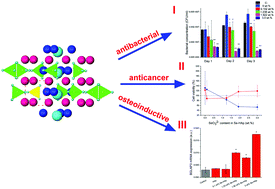One ion to rule them all: the combined antibacterial, osteoinductive and anticancer properties of selenite-incorporated hydroxyapatite
Abstract
Although hydroxyapatite (HAp) has been doped with dozens of different ions, the quest for an ion imparting a combination of properties conducive to bone healing is still ongoing. Because of its protean potency and the similarity in size and shape to the phosphate tetrahedron, the selenite ion presents a natural ionic substitute in HAp. The incorporation of selenite into synthetic HAp using two different methods – co-precipitation and ion-exchange sorption – was studied for its effect on crystal properties and on a triad of biological responses: antibacterial, anticancer and osteoinductive. Co-precipitation yielded HAp with a higher selenite content than sorption and the stoichiometry of HAp richest in selenite was represented as Ca9.75(PO4)5.75(SeO3)0.25(OH)1.75. The crystallinity of HAp decreased in direct proportion to the amount of selenite incorporated. Because of their lower selenite content, HAp powders prepared by ion-exchange exhibited a consistently higher crystallinity compared to the co-precipitated ones. Annealing partially recovered the crystallinity, yet the difference in crystallinity between powders prepared by co-precipitation and by ion-exchange remained, suggesting that the amorphization is mainly due to structural incorporation of selenite, not its effect on the crystal growth kinetics. The addition of selenite changed the morphology of the HAp nanoparticles from acicular to rounded and affected the crystal lattice parameters in different ways depending on whether the powders were annealed or not. As for the annealed powders, the incorporation of selenite contracted the lattice in both the a and c crystallographic directions. In the agar diffusion assay, the effectiveness of HAp was more dependent on the presence or absence of selenite in it than on its concentration and was the highest against E. coli and S. aureus, moderately high against S. enteritidis and ineffective against P. aeruginosa. In liquid inoculation tests, on the other hand, the antibacterial activity of HAp was directly proportional to the amount of selenite contained in it. The viability of K7M2 osteosarcoma cells decreased in direct proportion to the amount of selenite in HAp and was significantly different from the untreated control and from pure HAp at a content equal to or higher than 1.9 wt%. In contrast, no reduction was observed in the viability of primary fibroblasts treated with HAp incorporating different amounts of selenite ions, suggesting their potentially selective anticancer activity: lethal for cancer cells and harmless for healthy cells. Finally, mRNA expression of the bone gamma-carboxyglutamate protein (BGLAP3) was higher in differentiated MC3T3-E1 osteoblastic cells treated with selenite-incorporated HAp particles than in cells treated with pure HAp. The osteoinductive effect was due to an overall higher metabolic activity of cells treated with the particles and not due to increased proliferation. In such a way, a triad of antibacterial, osteoinductive and anticancer activities was attributed to selenite-incorporated HAp.



 Please wait while we load your content...
Please wait while we load your content...